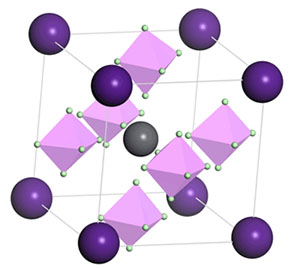| [1] Guo, X. D.; Niu, G. D.; Wang, L. D. Acta Chim. Sinica 2015, 73, 211. (郭旭东, 牛广达, 王立铎, 化学学报, 2015, 73, 211.)
[2] Wang, N. N.; Si, J. J.; Jin, Y. Z.; Wang, J. P.; Huang, W. Acta Chim. Sinica 2015, 73, 171. (王娜娜, 司俊杰, 金一政, 王建浦, 黄维, 化学学报, 2015, 73, 171.)
[3] Kojima, A.; Teshima, K.; Shirai, Y.; Miyasaka, T. J. Am. Chem. Soc. 2009, 131, 6050.
[4] Green, M. A.; Ho-Baillie, A.; Snaith, H. J. Nat. Photon. 2014, 8, 506.
[5] Jeon, N. J.; Noh, J. H.; Kim, Y. C.; Yang, W. S.; Ryu, S. C.; Seok, S, I. Nat. Mater. 2014, 13, 897.
[6] Kim, H. S.; Lee, C. R.; Im, J. H.; Lee, K. B.; Moehl, T.; Marchioro, A.; Moon, S. J.; Humphry-Baker, R.; Yum, J. H.; Moser, J. E.; Gr ätzel, M.; Park, N. G. Sci. Rep. 2012, 2, 591.
[7] Tang, H.; He, S. S.; Peng, C. W. Nanoscale Res. Lett. 2017, 12, 410.
[8] Ganose, A. M.; Savory, C. N.; Scanlon, D. O. J. Phys. Chem. Lett. 2015, 6, 4594.
[9] Jiang, Q. L.; Rebollar, D.; Gong, J.; Piacentino, E. L.; Zheng, C.; Xu, T. Angew. Chem., Int. Ed. 2015, 54, 7617.
[10] Umeyama, D.; Lin, Y.; Karunadasa, H. I. Chem. Mater. 2016, 28, 3241.
[11] Xiao, Z. W.; Meng, W. W.; Saparov, B.; Duan, H. S.; Wang, C. L.; Feng, C. B.; Liao, W. Q.; Ke, W, J.; Zhao, D. W.; Wang, J. B.; Mitzi, D. B.; Yan, Y. F. J. Phys. Chem. Lett. 2016, 7, 1213.
[12] Hendon, C. H.; Yang, R. X.; Burton, L. A.; Walsh, A. J. Mater. Chem. A 2015, 3, 9067.
[13] Nagane, S.; Bansode, U.; Game, O.; Chhatre, S.; Ogale, S. Chem. Commun. 2014, 50, 9741.
[14] Yao, Q. S.; Fang, H.; Deng, K. M; Kan, E.; Jena, P. Nanoscale 2016, 8, 17836.
[15] Fang, H.; Jena, P. J. Phys. Chem. Lett. 2016, 7, 1596.
[16] Andersen, T.; Haugen, H. K.; Hotop, H. J. Phys. Chem. Ref. Data. 1999, 28, 1511.
[17] Gutsev, G. L. Chem. Phys. 1981, 56, 277.
[18] Gutsev, G. L.; Boldyrev, A. I. Russ. Chem. Rev. 1987, 56, 519.
[19] Prigogine, I.; Rice, S. A. The Theoretical Investigation of the Electron Affinity of Chemical Compounds, Vol. 61, John Wiley Sons, Inc., New York, 2007, pp. 169~221.
[20] Gutsev, G. L.; Boldyrev, A. I. J. Phys. Chem. 1990, 94, 2256.
[21] Gutsev, G. L.; Boldyrev, A. I. Chem. Phys. Lett. 1984, 108, 250.
[22] Marchaj, M.; Freza, S.; Skurski, P. J. Phys. Chem. A 2012, 116, 1966.
[23] Marchaj, M.; Freza, S.; Skurski, P. Chem. Phys. Lett. 2014, 612, 172.
[24] Srivastava, A. K.; Misra, N. Mol. Phys. 2015, 113, 8, 866.
[25] Srivastava, A. K.; Misra, N. Polyhedron 2015, 102, 711.
[26] Anusiewicz, I.; Sobczyk, M.; Dabkowska, I.; Skurski, P. Chem. Phys. 2003, 291, 171.
[27] Sikorska, C.; Smuczynska, S.; Skurski, P.; Anusiewicz, I. Inorg. Chem. 2008, 47, 7348.
[28] Furuhashi, K.; Habasaki, J.; Okada, I. Mol. Phys. 1986, 59, 1329.
[29] Stadler, R.; Wolf, W.; Podloucky, R.; Kresse, G.; Furthmüller, J.; Hafner, J. Phys. Rev. B 1996, 54, 1729.
[30] Paier, J.; Marsman, M.; Hummer, K.; Kresse, G.; Gerber, I. C.; Ángyán, J. G. J. Chem. Phys. 2006, 124, 154709.
[31] Liu, G.; Liu, S. B.; Xu, B.; Ouyang, C. Y.; Song, H. Y. J. Appl. Phys. 2015, 112, 666.
[32] Even, J.; Pedesseau, L.; Jancu, J. M.; Katan, C. J. Phys. Chem. Lett. 2013, 4, 2999.
[33] Mosconi, E.; Amat, A.; Nazeeruddin, M. K.; Grätzel, M.; De Angelis, F. J. Phys. Chem. C 2013, 117, 13902.
[34] Zhao, Z. G.; Lu, X. Q.; Li, K.; Wei, S. X.; Liu, X. F.; Niu, K.; Guo, W. Y. Acta Chim. Sinica 2016, 74, 1003. (赵兹罡, 鲁效庆, 李可, 魏淑贤, 刘学锋, 牛恺, 郭文跃, 化学学报, 2016, 74, 1003.)
[35] Zhao, Z. G.; Niu, Y. Q.; Zhao, Y.; Song, Q. H.; Xin, L.; Lu, X. Q. Acta Chim. Sinica 2016, 74, 689. (赵兹罡, 牛永强, 赵洋, 宋清华, 忻灵, 鲁效庆, 化学学报, 2016, 74, 689.) |
